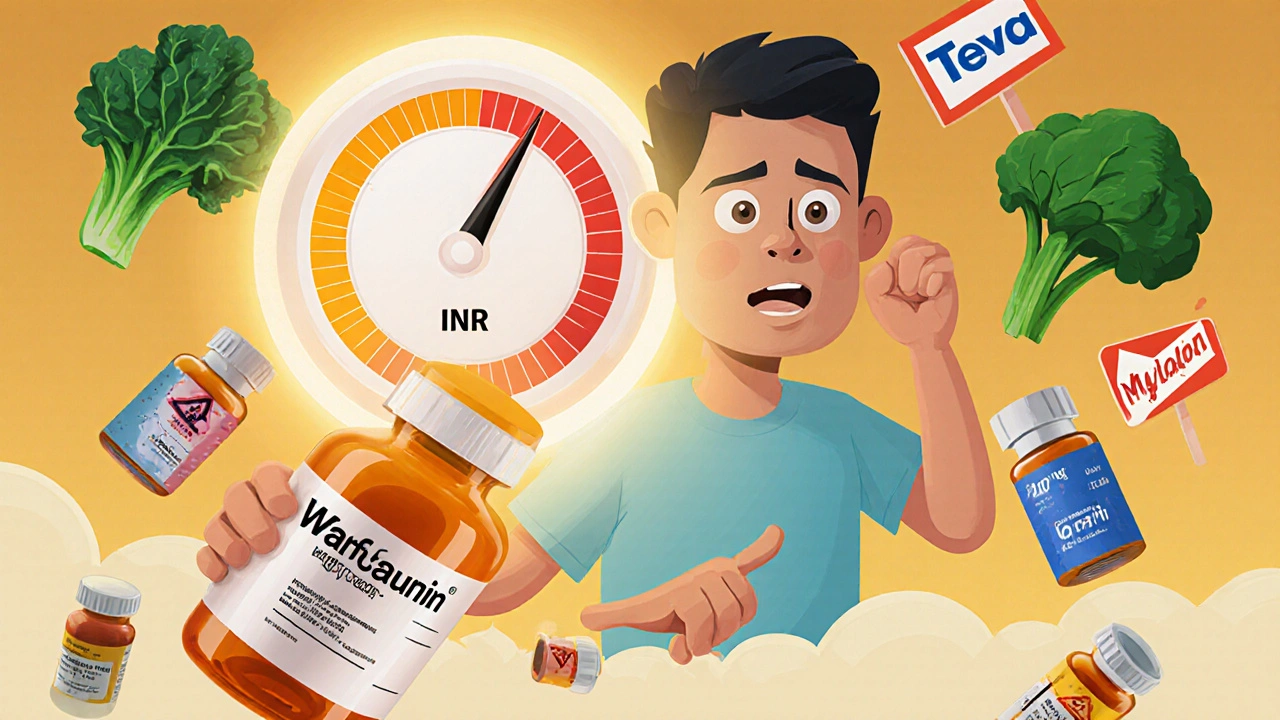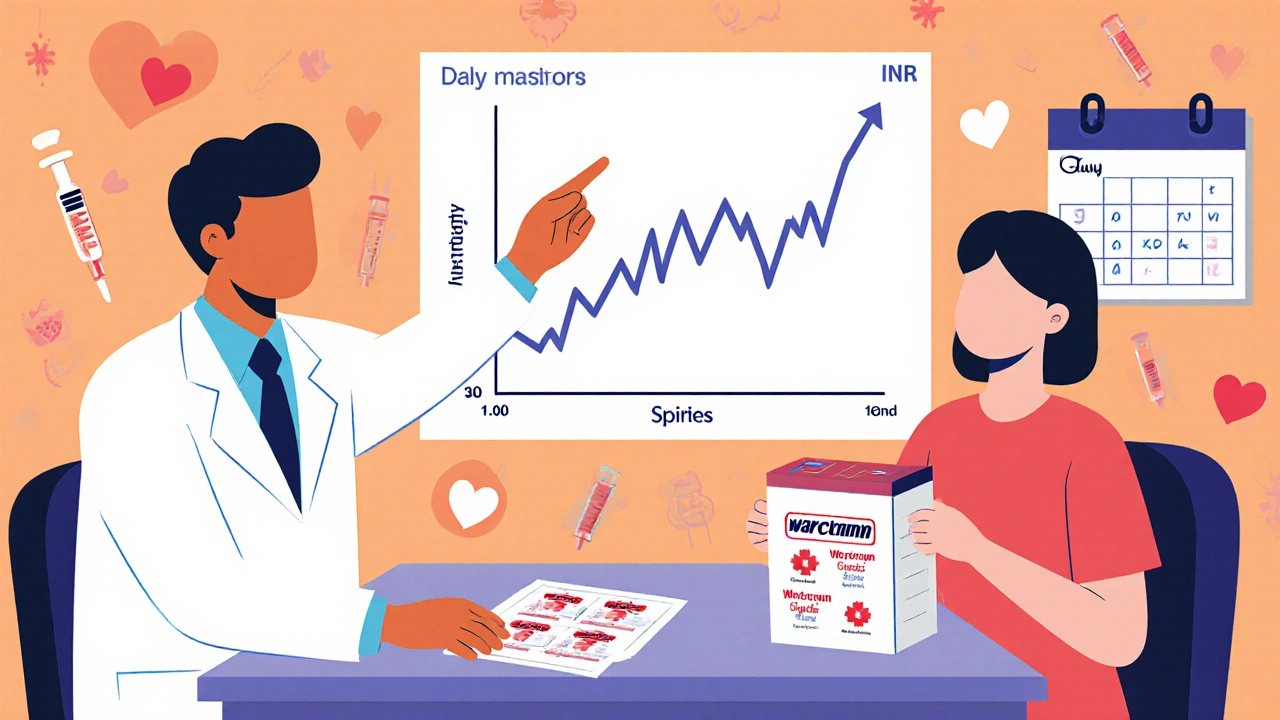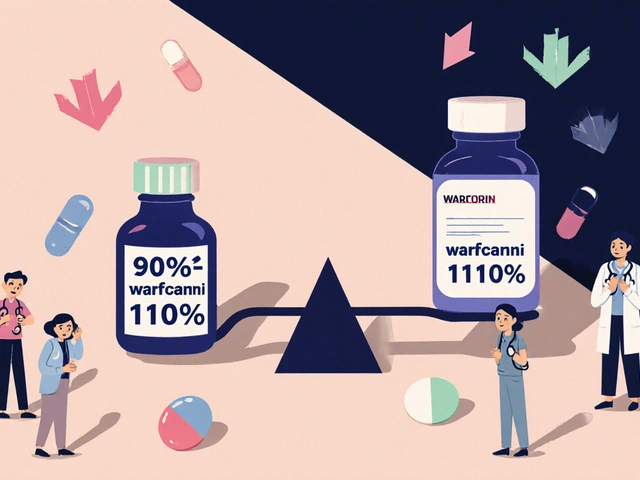Warfarin and Generic Switching: What You Need to Know About INR Monitoring and Safety

Switching from brand-name Coumadin to a generic version of warfarin sounds simple-cheaper, same drug, right? But for patients on warfarin, that switch isn’t just a pharmacy change. It’s a medical event. Warfarin isn’t like taking an ibuprofen or a statin. It’s a warfarin with a razor-thin safety margin. Too little, and you risk a stroke. Too much, and you could bleed internally. That’s why every time you switch brands-even if both are labeled "warfarin sodium"-your INR needs to be watched like a hawk.
Why Warfarin Is Different
Warfarin has been around since the 1950s. It’s old, it’s cheap, and it still saves lives. But it’s not forgiving. The difference between working right and causing harm is tiny. For most people, the target INR is between 2.0 and 3.0. Go below 2.0? Your blood clots too easily. Above 3.0? You’re at risk of serious bleeding-even a minor bump can turn dangerous.What makes warfarin tricky isn’t just the dose. It’s how your body handles it. Your liver breaks it down using enzymes called CYP2C9 and CYP3A4. Those same enzymes process hundreds of other drugs-antibiotics, painkillers, even some herbal supplements. A new medication, even a one-time dose, can throw your INR off in less than 72 hours. And your diet matters too. Eating a big plate of kale or spinach? That’s vitamin K, which directly fights warfarin’s effect. A sudden change in your greens intake can spike or drop your INR without warning.
Generic Warfarin: Same Drug, Different Results?
The FDA says all approved generic warfarin products are "therapeutically equivalent" to Coumadin. That means, in theory, they should behave the same way in your body. And for most people, they do. Large studies, including one tracking over 40,000 patients, found no significant difference in INR control or bleeding risk between brand and generic versions.But here’s the catch: those studies looked at groups. Not individuals.
Some patients-about 15 to 20%-see their INR swing after switching. Not because the generic is "bad," but because tiny differences in how the drug is made-fillers, binders, coating-can change how fast it’s absorbed. With a drug as sensitive as warfarin, even a 5% change in absorption can push you out of your safe range.
One study from a St. Louis HMO followed 182 patients who switched from Coumadin to a generic made by Barr Laboratories. No major changes in INR, no increase in clots or bleeds. But that was one generic brand. What if you switch again-to a different manufacturer? Teva? Mylan? Sandoz? Each has its own formula. And the FDA doesn’t require manufacturers to test their product against every other generic. Only against the original brand.
When You Switch, Monitor Like Your Life Depends on It (Because It Does)
If you’re switching from Coumadin to generic warfarin-or from one generic to another-don’t assume everything will be fine. Treat it like starting the drug for the first time.Here’s what works:
- Get your INR checked within 3 to 5 days after the switch.
- Check again in 3 to 7 days.
- Then weekly for the next 2 to 4 weeks.
- Only return to your normal schedule (every 4 to 6 weeks) if your INR stays steady for two consecutive tests.
Some clinics go even further: daily INR checks for the first week. That’s not overkill. It’s standard practice for high-risk patients. The Cleveland Clinic recommends this approach for anyone switching, especially if they’ve had unstable INR in the past.
And don’t forget: your doctor needs to know exactly which generic you’re taking. Not just "warfarin." The manufacturer and lot number. If your INR suddenly drops, and you’ve switched generics, that’s the first thing your provider will ask. Write it down. Keep the bottle. If you’re on Medicare or Medicaid, your pharmacy might change your generic without telling you. Ask. Always ask.

What Else Can Throw Off Your INR?
Switching generics isn’t the only risk. Here’s what else can mess with your INR:- New medications: Antibiotics like metronidazole or amiodarone can boost warfarin’s effect. Some antifungals and even OTC cold meds can too.
- Diet changes: Eating more leafy greens? Less alcohol? Both can shift your INR. Keep your vitamin K intake steady.
- Illness: Fever, diarrhea, or liver problems can change how your body handles warfarin.
- Missing doses: One missed pill can drop your INR. Two missed pills? That’s a red flag.
- Lab errors: Not all INR machines are the same. If your numbers suddenly look weird, ask if the lab changed equipment or reagents.
If your INR goes out of range and you can’t find a reason, don’t guess the dose. Don’t double up. Don’t skip. Call your anticoagulation clinic. Adjustments are usually small-5% to 10% of your daily dose. Too big a change can be dangerous.
Warfarin vs. DOACs: The Real Choice
Newer anticoagulants-apixaban, rivaroxaban, dabigatran-are called DOACs. They don’t need daily INR checks. No diet restrictions. Fewer drug interactions. That’s why they’ve taken over 65% of new prescriptions since 2015.But here’s the truth: DOACs aren’t for everyone.
- If you have a mechanical heart valve, DOACs are dangerous. Warfarin is the only option.
- If you have severe kidney disease, many DOACs aren’t safe. Warfarin still works.
- If you’re on a tight budget, warfarin costs $4 to $10 a month. DOACs? $300 to $500.
- If you need emergency reversal-say, after a fall-warfarin can be undone with vitamin K or fresh frozen plasma. DOAC reversal is expensive, complex, and not always available.
So if you’re stable on warfarin, with good INR control, there’s no rush to switch. But if you’re tired of weekly blood tests, or your INR is always jumping around, talk to your doctor about DOACs. It might be worth the cost.

What to Do Right Now
If you’re on warfarin, here’s your action plan:- Check your prescription bottle. Write down the manufacturer name.
- Call your pharmacy. Ask if your generic brand changed last refill.
- If it did, schedule an INR test within 5 days.
- Keep a log: date, dose, INR, any new meds, diet changes.
- Never refill without confirming the generic brand.
- If your INR is unstable, ask about genetic testing (CYP2C9/VKORC1). It’s not routine, but it can predict who’s more likely to react to switches.
Warfarin isn’t going away. Even with DOACs rising, it’s still the only option for hundreds of thousands of people. And for them, generic switching isn’t a cost-saving trick-it’s a safety challenge.
There’s no magic fix. But if you stay informed, stay consistent, and stay in touch with your care team, you can manage it safely. The goal isn’t to avoid switching. It’s to switch smart.
Can I switch between different generic warfarin brands without testing my INR?
No. Even though all generic warfarin products are FDA-approved as equivalent, switching between manufacturers can cause your INR to shift. Always check your INR within 3 to 5 days after switching to a new generic brand. Some patients may need daily checks for the first week.
Is generic warfarin less safe than Coumadin?
Not inherently. Large studies show no overall increase in bleeding or clotting risk when switching from Coumadin to generic warfarin. But individual patients can react differently due to small variations in how the drug is absorbed. That’s why close monitoring after a switch is critical.
How often should I get my INR checked if I’m stable on warfarin?
Once your INR is stable for several months, most guidelines recommend checking every 4 to 6 weeks. But if you’ve recently switched generics, had a dose change, started a new medication, or changed your diet, check more often-weekly or even daily-until your INR is steady again.
Why does my INR change when I eat more greens?
Leafy greens like spinach, kale, and broccoli are high in vitamin K, which helps your blood clot. Warfarin works by blocking vitamin K’s effect. If you suddenly eat more greens, your body has more vitamin K to fight warfarin, which can lower your INR. The key is consistency-not cutting out greens, but keeping your intake steady from week to week.
Should I switch from warfarin to a DOAC?
It depends. DOACs don’t require regular INR tests and have fewer food and drug interactions. But they’re much more expensive and aren’t safe for everyone-especially those with mechanical heart valves or severe kidney disease. If you’re doing well on warfarin and can manage the monitoring, there’s no urgent need to switch. Talk to your doctor about your lifestyle, budget, and health needs before deciding.
What should I do if my INR is too high or too low?
Don’t adjust your dose yourself. Call your anticoagulation clinic or doctor immediately. For a slightly high INR, they might skip your next dose or reduce it slightly. For a very high INR (above 5.0), you may need vitamin K or even hospital care. For a low INR, they may increase your dose-but only after ruling out missed doses or other causes.
Are there warning signs I’m bleeding too much on warfarin?
Yes. Watch for unusual bruising, nosebleeds that won’t stop, pink or red urine, dark or tarry stools, severe headaches, or sudden pain/swelling in joints. If you fall or hit your head, get checked even if you feel fine. Internal bleeding can be silent at first.
Final Thought: Know Your Warfarin, Own Your Safety
Warfarin isn’t a drug you take and forget. It’s a partnership between you and your care team. The generics are cheaper, yes-but they demand more attention, not less. The best outcome isn’t the lowest price. It’s the most stable INR. And that comes from knowing your dose, your brand, your diet, and when to call your doctor. Stay informed. Stay vigilant. Your life depends on it.1 Comments
Pallab Dasgupta
Man, I’ve been on warfarin for 8 years and I still get nervous when the pharmacist hands me a different bottle. Not because I don’t trust the science, but because I’ve seen my INR go from 2.8 to 4.1 in 48 hours after they switched me to some random generic. No drama, no warning-just a call from my clinic saying I nearly bled out. Don’t let anyone tell you it’s just a pill. It’s a tightrope walk.






Write a comment